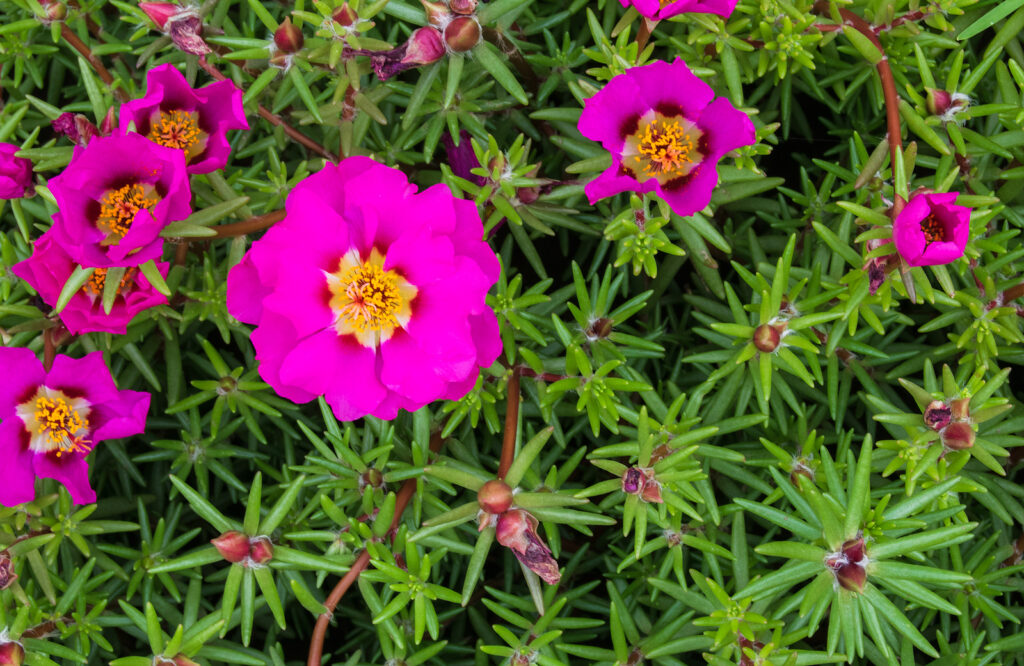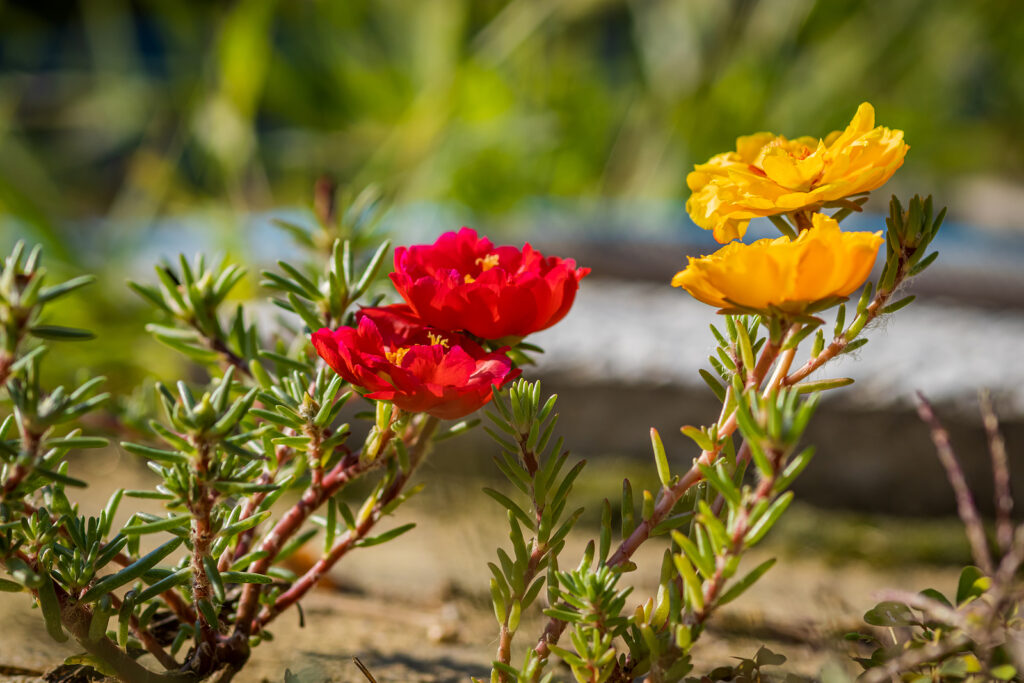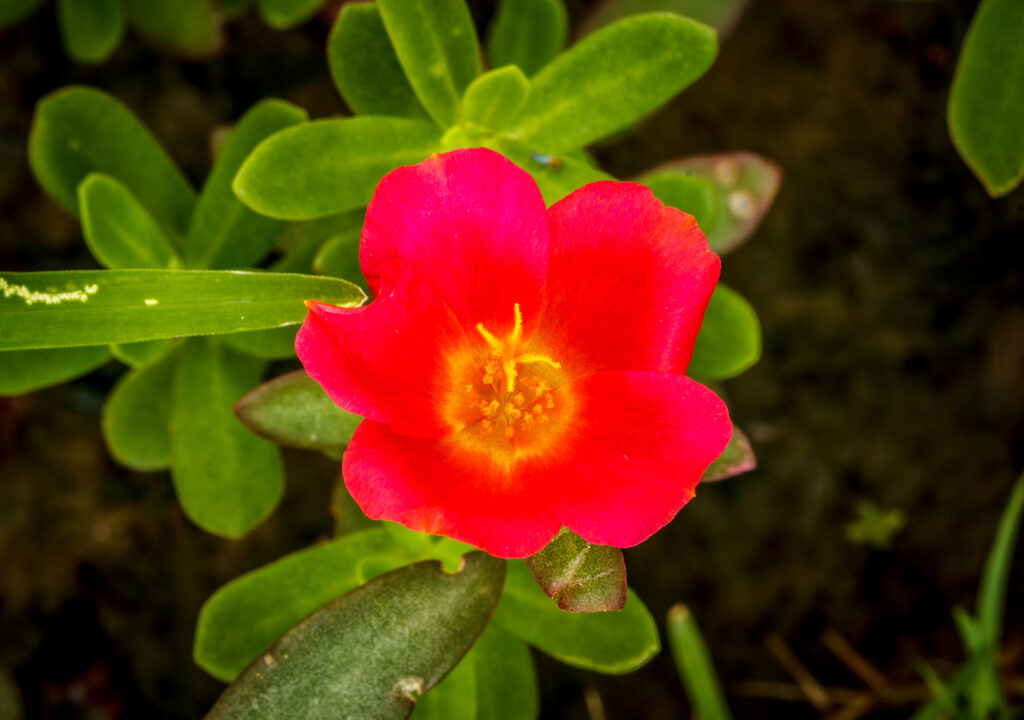Portulaca–commonly called moss rose–produces single or double, satin-textured, rose-pink, red, yellow, or white flowers to 1 inch (2.5cm) across in summer. Flowers typically open only in bright sunlight.
Portulaca is an old-fashioned favorite. It flourishes in sunny, dry areas where few other plants will grow. Flowers open fully in sun and close in the late afternoon.
Portulaca is a semi-succulent, spreading annual. Clusters of cylindrical, fleshy leaves are bright to mid-dark green on trailing stems.
There are two popular species of Portulaca; they are moss rose and purslane. Moss rose has fat, needle-shaped leaves; purslane has fat, oval leaves. Both plants are spreading and are a good choice for temporary ground cover. They can also be used in hanging baskets, rock gardens, and edging.
Flower Garden Success Products at Amazon:
- Wildflower Seed Mix Attracts Hummingbirds and Butterflies
- Eden Brothers All Perennial Seed Mix
- 10 pcs Stainless Steel Garden Hand Tool Set
- Gorilla Cart 4 Cu. Ft, 300-pound Capacity
- Neem Bliss 100-% Cold Pressed Neem Oil
- Safer Brand Insect Killing Soap

Get to know Portulaca
- Plant type: Annual
- Growing Zones and range: Annual in all zones
- Hardiness: Killed by frost; established plants can tolerate hot and dry conditions
- Height and width: 4 to 8 inches (10-20cm) tall; 8 to 18 inches (20-45cm) wide
- Foliage: Narrow, tubular, and succulent leaves on reddish well-branched stems
- Flowers: Small, roselike single or double flowers usually about 1 inch (2.5cm) wide
- Flower colors: Red, orange, yellow, purple, or pink flowers; some varieties open about noon and close in the afternoon; new cultivars have variegated flower petals and stay open all day.
- Bloom time: Spring to frost
- Uses: Beds, containers
- Common name: Moss Rose
- Botanical name: Portulaca grandiflora
- Family: Portulacaceae
- Origin: Warm temperate and tropical regions of the world
Where to plant Portulaca
- Grow Portulaca in full sun.
- Plant Portulaca in average, well-drained soil, preferably sandy.
- Portulaca prefers a soil pH of 6.5 to 7.5.
Portulaca uses
- Portulaca is an excellent choice for rock gardens, containers, and hanging baskets.
- Portulaca can be grown in hanging baskets or containers where it will cascade over the sides.

When to plant Portulaca
- Set Portulaca in the garden in spring after all danger of frost has passed.
- Start seed indoors 4 to 8 weeks before the last frost in spring.
- Sow seeds outdoors during warm weather; plant seeds in winter in Zones 10-11.
- Set transplants in the garden after all danger of frost has passed; harden off plants for a few days before transplanting.
Planting and spacing Portulaca
- Sow Portulaca seed thinly; barely cover the seeds with soil.
- Seeds germinate in about 7 days at 75°F (24°C).
- Sow seeds indoors in small pots or flats filled with moist potting soil; grow seedlings in bright light or below fluorescent light.
- Sow seeds outdoors in well-worked, smooth soil; press seeds into the soil, barely covering them.
- Thin seedlings growing outdoors when crowded.
- Set Portulaca transplants in the garden after all danger of frost has passed.
- Space Portulaca 1 to 2 feet (30-61cm) apart.
How to water and feed Portulaca
- Keep the soil just moist until plants are established.
- Once established water Portulaca sparingly, allowing the soil to dry between waterings.
- Lightly fertilize moss roses at planting with an all-purpose fertilizer. Fertilize periodically during active growth.

Portulaca care
- Mulch around plants in very dry areas; mulch with aged compost or chopped leaves.
Portulaca pests and diseases
- Portulaca is susceptible to aphids, thrips, and white rust.
Good Products for Seed Starting Success at Amazon:
- Jump Start Germination Station w/Heat Mat Tray, 72-Cell Pack, Dome
- Espoma Seed Starting Mix
- 200 Count- Jiffy 7 Peat Soil Seed Starting Plugs
- Seed Starter Kit with Humidity Dome (120 Cells Total Tray)
- AgrobriteT5 Fluorescent, 2-Foot, Grow Light System
Portulaca propagation
- Sow seeds indoors 6 to 8 weeks before the last frost.
- Germination occurs in 10 to 14 days at 70° to 80°F (21°-27°C).
- Portulaca will self-sow.
- Propagate Portulaca by rooting cuttings off the stem section in spring.
- Take a 4-inch cutting, remove the bottom leaves, and plant in shady, moist, humus-rich, or sandy soil.

Portulaca varieties to grow
- Portulaca grandiflora has needle-shaped leaves topped with fluffy flowers; this is a favorite garden annual
- ‘Sundial’ and ‘Sundance’ cultivars have flowers that remain open all day; older varieties close in the afternoon.
- Portulaca oleracea, purslane, has bright single flowers and succulent, prostrate stems.
Portulaca frequently asked questions
Q: Can I grow portulaca from seed?
A: Portulaca is easy to grow from seed sown outdoors after all danger of frost has passed. Grow portulaca in well-drained, dry, light, sandy, but not rich soil, in full sun. You can start portulaca indoors 6 to 8 weeks before the last frost for transplanting into the garden after the last frost. Seeds germinate in about 10 to 15 days at 70°F.
Q: Doe portulaca self-sow?
A: Portulaca readily self-sows, but seedlings do not appear until late spring after the soil has warmed. Thin crowded seedlings and transplant them to an open space.
Q: Where is a good place for portulaca in the garden?
A: Portulaca is low-growing and nearly prostrate. It can be grown at the front of a bed or border or at the front or edge of a container. It is a tough plant and will not languish if you forget to water it.
Related Articles:
- 20 Perennials That Bloom for 6 to 8 Weeks
- Shrubs with Showy Flowers Season-by-Season
- Trees in Garden Design
- Growing Annuals for Summer Bloom
- Trees—click here for more articles
- Shrubs—click here for more articles
- Perennials—click here to see more
- Annuals—click here to see more















